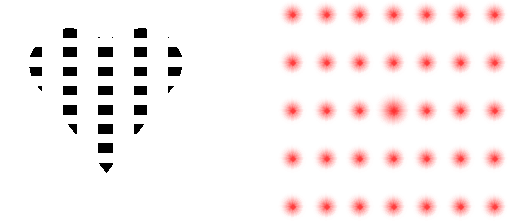Questions
-
Which of the masks below could have produced the following diffraction pattern?


-
Increasing the spread of the diffraction pattern allows for more accurate measurement of the spot spacing. Which one of these will achieve this?
-
When the diffraction pattern from a particular grating is projected onto a screen, the even diffraction spots are missing, i.e. the second, fourth, etc. What is the relationship between the width of the slits (w) of the grating and the distance between each slit (s)?
-
The diffraction pattern from a single slit is projected onto a screen 0.90 m from the slit. Seven spots are visible, with a bright central spot. The maxima of the outer spots are a distance of 15 cm apart. A He-Ne laser is used, which produces light of a wavelength of 0.6328 μm. What is the width of the slit?
-
A convex lens has a focal length of 150 mm. If it is placed 180 mm from a mask on an optical bench, where must the screen be placed in order to focus the diffracted light into a sharp image?
-
As in the previous question, a convex lens has a focal length of 150 mm and is placed 180 mm from a mask on an optical bench. Where must the screen be placed in order to observe the diffraction pattern?
-
As in the previous questions, a convex lens has a focal length of 150 mm and is placed 180 mm from a mask on an optical bench, giving an image distance of 900 mm. What is the magnification of the object in this set-up?
-
As in the previous questions, a convex lens has a focal length of 150 mm and is placed 180 mm from a mask on an optical bench, giving an image distance of 900 mm. If the above lens is 56 mm in diameter, what is the finest grating size that could be resolved theoretically using light of wavelength 0.6328 μm?
-
The theoretical resolution of a microscope is given by

where n is the refractive index of the medium (n = 1 for air) and sinα is known as the numerical aperture, N.A. (commonly printed on the side of a lens). If a microscope can just resolve a "400 lines per mm" grating, what would the N.A. of the lens be?
-
A diffraction pattern shows just two-fold symmetry. Which one of these apertures could not have produced such a pattern?

-
The following heart-shaped aperture produces the adjacent diffraction pattern.

Which of the following masks should be placed in the back focal plane in order to best study the horizontal stripes of the aperture in the image? Dashed lines are shown to identify location of central diffraction spot with respect to mask.


